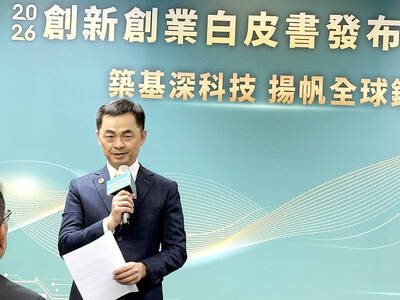The global semiconductor industry will likely see its revenue increase by 8 percent this year on the back of increasing shipments of memory chips, statistics released yesterday by trade group SEMI showed.
The global industry last year saw its revenue rise 20 percent annually to more than US$400 billion for the first time in history, the statistics showed.
“We are optimistic about this year’s growth prospects. Revenue growth will range from 4 to 8 percent year-on-year, based on the projected figures we compiled, which is an above-average growth,” Taipei-based SEMI analyst Clerk Tseng (曾瑞榆) told a media briefing.
Chip market forecaster Future Horizons Ltd predicted annual growth of 10 percent, Tseng said.
Future Horizons’ forecast is noteworthy, as its estimate of 17 percent growth for last year was very close to the actual figure, he added.
This year’s growth would mostly be driven by the increase in memory chip shipments, rather than a rally in average selling price (ASP) as was seen last year, Tseng said.
Memory chip ASP is expected to be flat this year, as demand is expected to climb at least 30 percent annually through 2021, given significant capacity expansion plans by Samsung Electronics Co, SK Hynix Inc and Micron Technology Inc, he said, citing figures from semiconductor researcher Objective Analysis.
Memory chips are to make up between 25 and 30 percent of overall semiconductor revenue this year, compared with less than 25 percent in the past, he said.
Data centers, industrial applications, consumer electronics, wireless devices and automotive electronics are likely to continue to drive growth in the industry this year, extending last year’s momentum, Tseng said.
Worldwide semiconductor revenue is expected to top US$500 billion by next year, he said.
There will be diverse growth factors affecting the global industry from this year to 2025, such as artificial intelligence, high-performance computing, automotive, Internet of Things and 5G, he added.
As for the market trend in the silicon wafer segment, “there is the likelihood that manufacturers will raise ASP by 100 percent this year, given a persistent supply crunch,” Tseng said.
Silicon wafer prices peaked in 2007 and had been declining until a rebound last year, when ASP jumped 17 percent due to supply constraints, SEMI data showed.
“It would take price hikes of 300 percent to bring the silicon wafer price back to the level seen 10 years ago,” Tseng said. “However, we do not expect a hike in ASP will increase the retail prices of end products, as it only accounts for a very small portion of chip costs.”

CHIP RACE: Three years of overbroad export controls drove foreign competitors to pursue their own AI chips, and ‘cost US taxpayers billions of dollars,’ Nvidia said China has figured out the US strategy for allowing it to buy Nvidia Corp’s H200s and is rejecting the artificial intelligence (AI) chip in favor of domestically developed semiconductors, White House AI adviser David Sacks said, citing news reports. US President Donald Trump on Monday said that he would allow shipments of Nvidia’s H200 chips to China, part of an administration effort backed by Sacks to challenge Chinese tech champions such as Huawei Technologies Co (華為) by bringing US competition to their home market. On Friday, Sacks signaled that he was uncertain about whether that approach would work. “They’re rejecting our chips,” Sacks

NATIONAL SECURITY: Intel’s testing of ACM tools despite US government control ‘highlights egregious gaps in US technology protection policies,’ a former official said Chipmaker Intel Corp has tested chipmaking tools this year from a toolmaker with deep roots in China and two overseas units that were targeted by US sanctions, according to two sources with direct knowledge of the matter. Intel, which fended off calls for its CEO’s resignation from US President Donald Trump in August over his alleged ties to China, got the tools from ACM Research Inc, a Fremont, California-based producer of chipmaking equipment. Two of ACM’s units, based in Shanghai and South Korea, were among a number of firms barred last year from receiving US technology over claims they have

BARRIERS: Gudeng’s chairman said it was unlikely that the US could replicate Taiwan’s science parks in Arizona, given its strict immigration policies and cultural differences Gudeng Precision Industrial Co (家登), which supplies wafer pods to the world’s major semiconductor firms, yesterday said it is in no rush to set up production in the US due to high costs. The company supplies its customers through a warehouse in Arizona jointly operated by TSS Holdings Ltd (德鑫控股), a joint holding of Gudeng and 17 Taiwanese firms in the semiconductor supply chain, including specialty plastic compounds producer Nytex Composites Co (耐特) and automated material handling system supplier Symtek Automation Asia Co (迅得). While the company has long been exploring the feasibility of setting up production in the US to address

OPTION: Uber said it could provide higher pay for batch trips, if incentives for batching is not removed entirely, as the latter would force it to pass on the costs to consumers Uber Technologies Inc yesterday warned that proposed restrictions on batching orders and minimum wages could prompt a NT$20 delivery fee increase in Taiwan, as lower efficiency would drive up costs. Uber CEO Dara Khosrowshahi made the remarks yesterday during his visit to Taiwan. He is on a multileg trip to the region, which includes stops in South Korea and Japan. His visit coincided the release last month of the Ministry of Labor’s draft bill on the delivery sector, which aims to safeguard delivery workers’ rights and improve their welfare. The ministry set the minimum pay for local food delivery drivers at